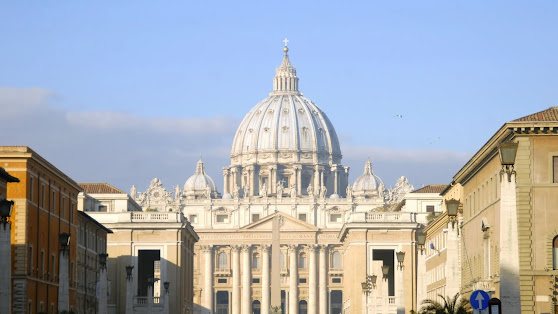Cupola (pronounced kyoo-puh-luh)
(1) In architecture, a light structure on a dome or roof,
serving as a belfry, lantern, or belvedere (some functional, some merely ornamental).
(2) Any of various dome-like structures (especially in
architecture or one covering a circular or polygonal area).
(3) In naval architecture, a protective dome for guns on
a warship
(4) In armored vehicles, a raised structure with a narrow
aperture for viewing, sometimes fitted with a gun or flame-thrower.
(5) In geology, an upward-projecting mass of plutonic
rock extending from a larger batholith.
(6) In metallurgy, a vertical, air-blown coke-fired
cylindrical furnace in which iron is re-melted for use in casting.
(7) In geometry, a solid formed by joining two polygons,
one (the base) with twice as many edges as the other, by an alternating band of
isosceles triangles and rectangles.
(8) In anatomy, a small cap over a structure, shaped like
a dome or inverted cup.
(9) In railway carriage design, a small viewing window in
the top of the caboose (guard’s van) for looking over the train, or the part of
the caboose where one looks through this window (obsolete).
1540–1550: From the Italian cupola, from the Late Latin cūpula
(a small cask; a little tub), from the Classical Latin cuppella, from cuppa
& cūpa (tub), from the Ancient
Greek κύπελλον (kúpellon) (small cup),
the construct being cūp(a) + -ula,
from the primitive Indo-European -dlom
(the instrumental suffix) and used as a noun suffix denoting an instrument. The origin in Latin was based on the resemblance
to an upturned cup, hence the use to describe the rounded top of just about any
structure where no specific descriptor existed.
Cupola is a noun and cupolated & cupolar are adjectives; the noun
plural is cupolas or cupolae.
Cupola on the dome of St Peter's Basilica, Vatican City, Rome.
In architectural history, the cupola is considered a
descendent of the oculus, which may seem strange given the evidence suggests domes
came first but a cupola is something which can be added to a dome and the
earliest may have been “bolted on” when the open nature of an oculus proved
troublesome. Fitted with one or more
windows, they would still permit the entry of light but keep out the wind and
rain. From this functional origin, they
became popular as features to crown turrets, roofs, and larger dome. Confusingly, architects at one point decided a
cupola was also the inner vault of a dome so historic plans and descriptions
need to be read with care. Although
classically dome-like in shape, most modern cupolas are more angular.
Onion domes on the Kremlin, Red Square, Moscow, Russia.
Cupolas were a favorite in early Islamic architecture and began their proliferation the mid-late eighth century, presumably because they were a perfect decorative addition to a mosque’s minarets but such was the appeal they would appear also in the core of the building or at its corners. Before long, they were a regular part of commercial and residential buildings, valued not only as decoration but as a light source and for the ease with which they could sit atop vertical ducts used for ventilation. It was the Islamic influence which was responsible for the best known motif of Russian architecture, the onion dome which was well suited to the northern climate because, constructed with severe lines, effortlessly they resisted the gathering of snow. The Moors brought the design to Spain and whatever religious conflicts may for centuries have disfigured the Middle East & Europe, Architectural taste proved ecumenical and onion domes can still be seen atop Christian churches in Austria and southern Germany.
US Marine Corps M17 flame-thrower in use, the M1919A4 Browning .30 caliber medium machine gun to the right is hard-mounted in the tank commander's cupola, South Vietnam, 1968.
In military use, a cupola is basically a helmet fixed in
place and that may be on a building, a ship or an armored vehicle, the function
being to protect the head while offering a field of view. Sometimes, especially in tanks or armored cars,
guns or flame-throwers were integrated into cupolas and in naval gunnery, there
was the special use to describe the dome-like structures protecting a (usually single)
gun mounting, something which distinguished them from the larger, flatter
constructions which fulfilled the same purpose for multi-gun batteries.
Cupola on the International Space Station (ISS), outside & in. Cupolas are used on space craft because they are a way of maximizing the window space for a certain amount of the hull’s surface area.
McMansion with turrets and cupola.
Although the moment seems to have passed, one recent
trend in domestic architecture which really disturbed the arbiters of style was
the proliferation in parts of the US of McMansions, huge houses of sometimes
dubious build quality often in a confusion of architectural styles and adorned
with balconies, turrets, columns and cupolas, the more the better.





No comments:
Post a Comment